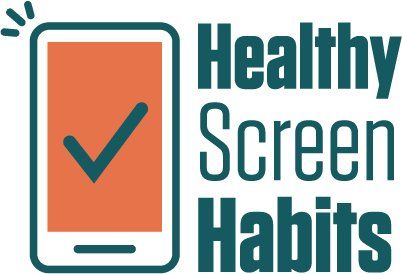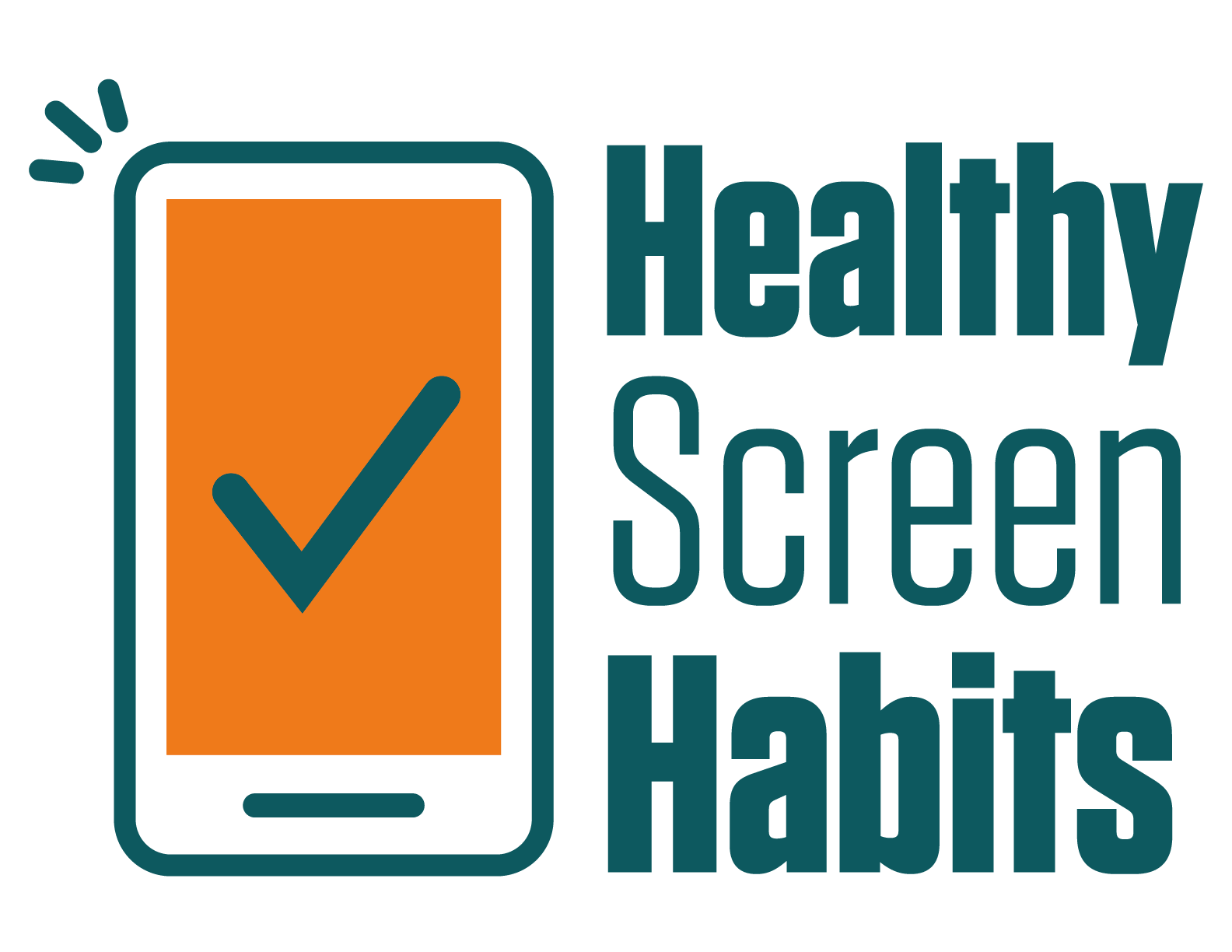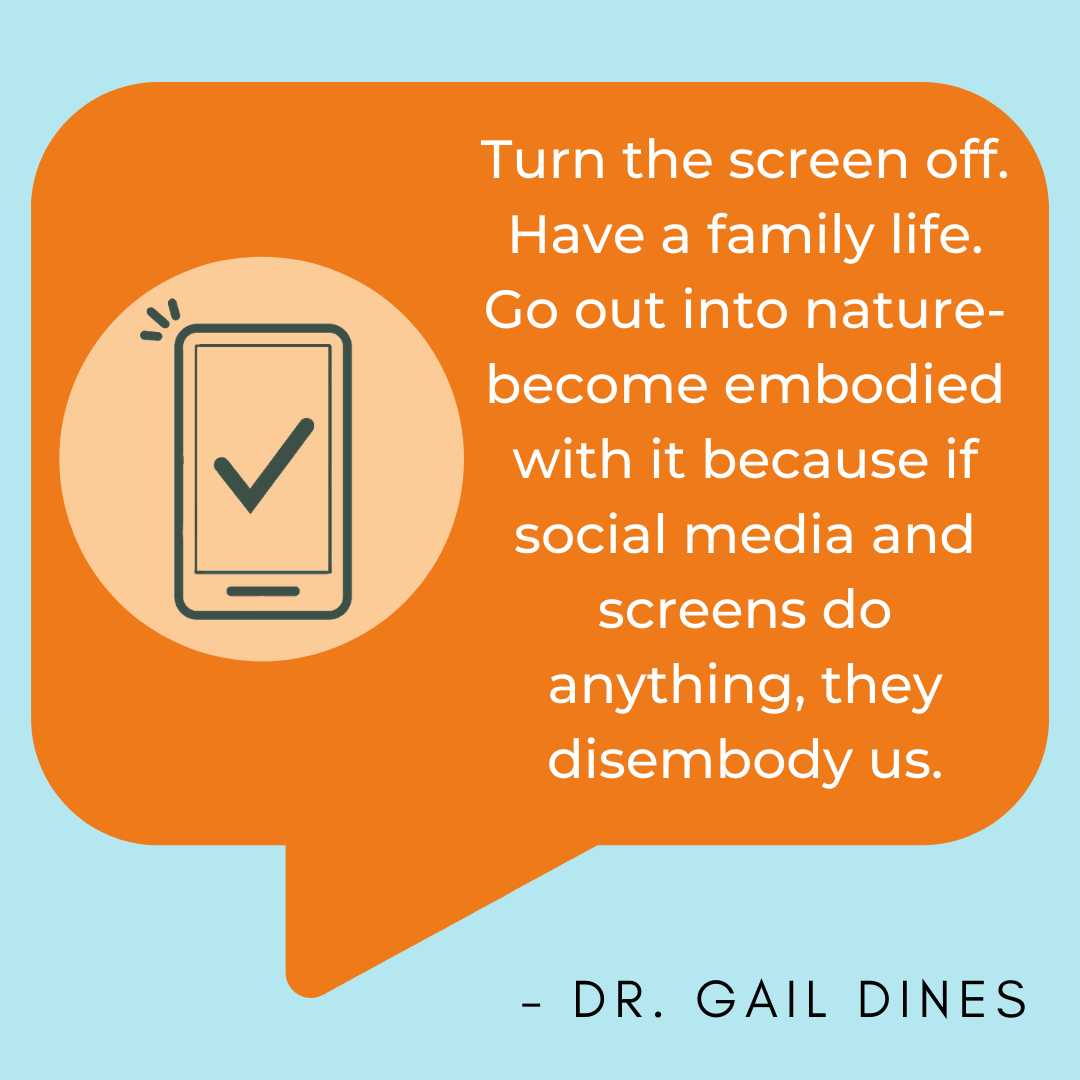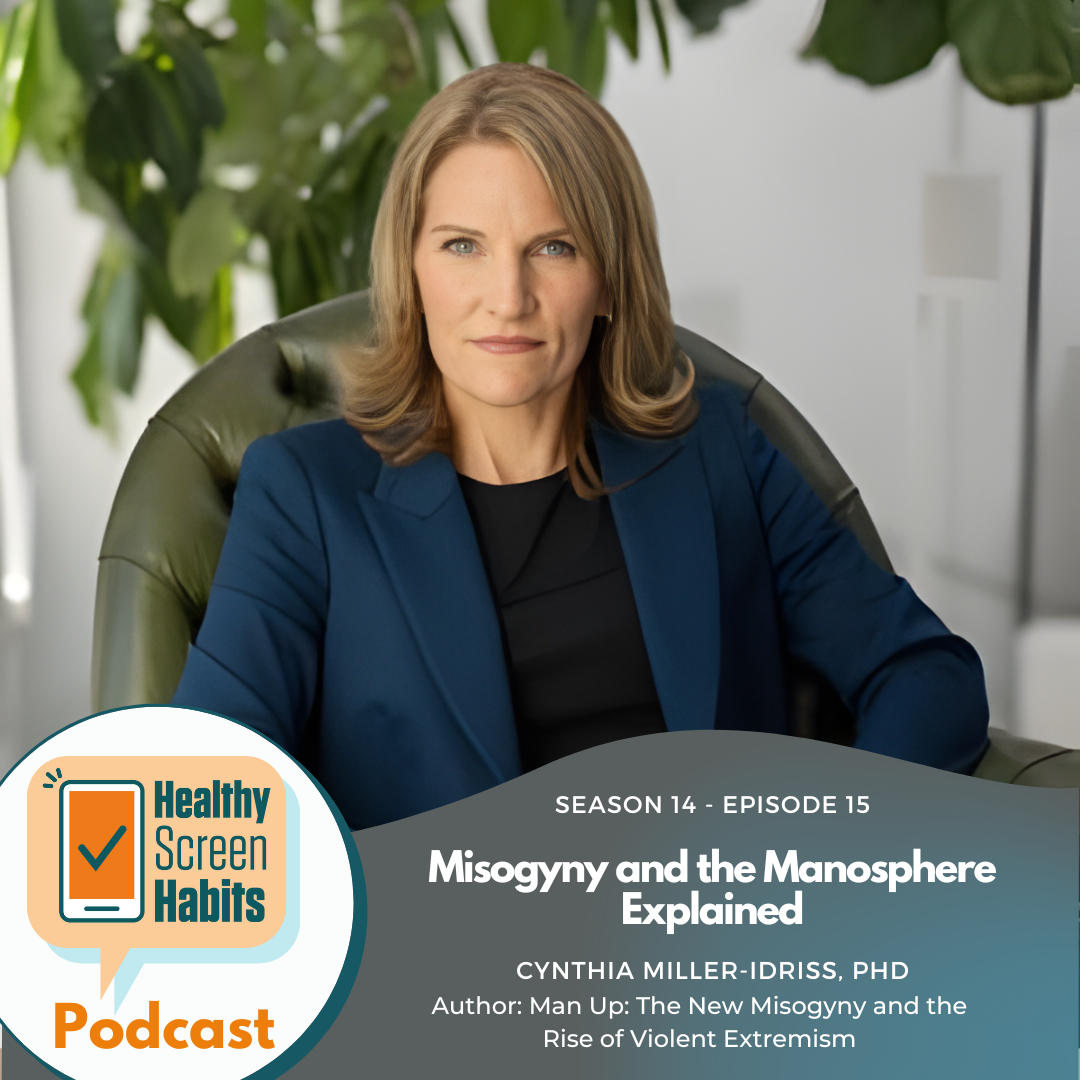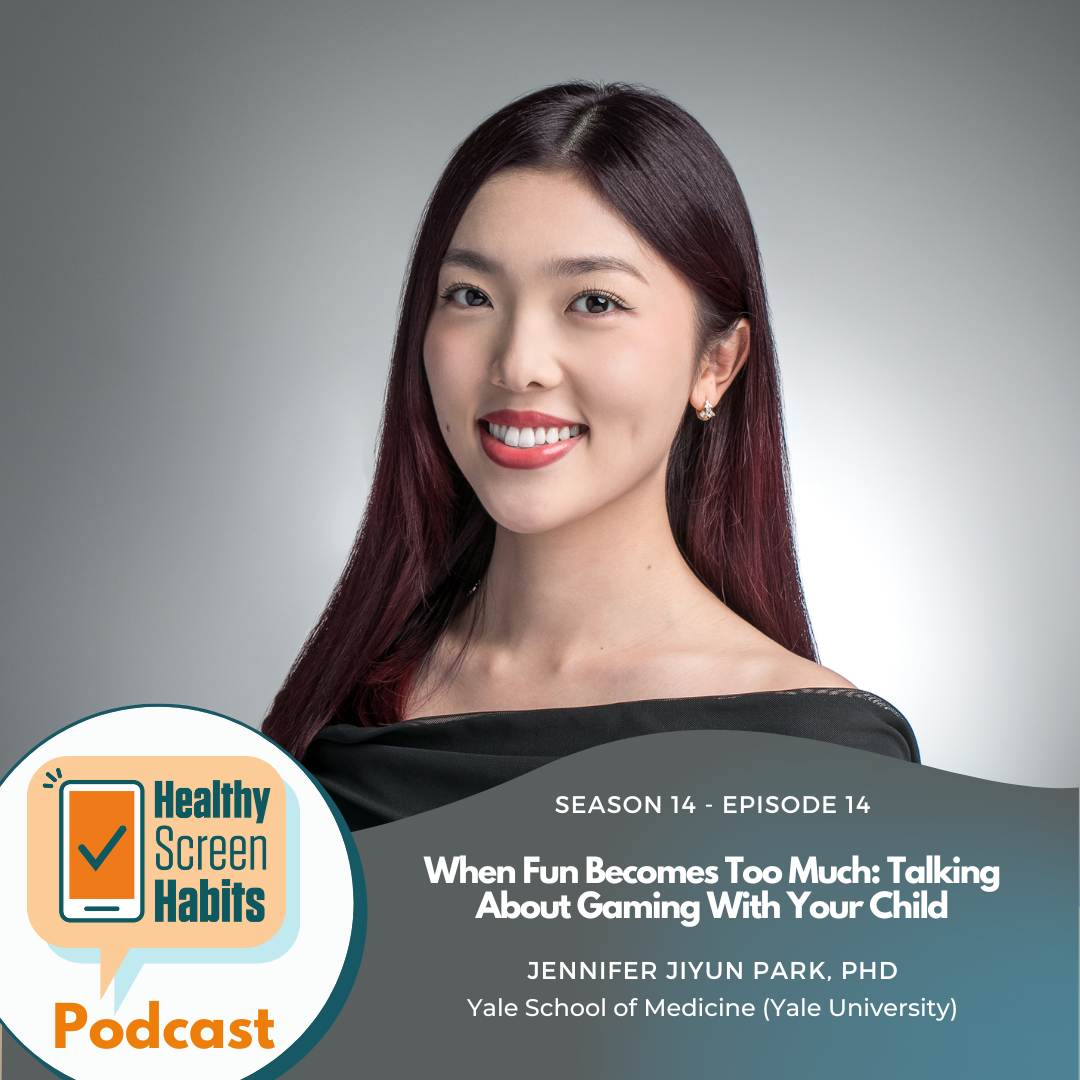S2 Episode 3: How to Talk About Pornography // Dr. Gail Dines of Culture Reframed
Hosted by Hillary Wilkinson
"Porn is the sexual script for teens… porn is now the major form of sex ed."
- Dr. Gail Dines
Dr. Gail Dines has been researching and writing about the harms of pornography for over 30 years. Using scientific studies and data as the backbone to her organization, Culture Reframed, Gail explores behavioral and mental problems that arise with early/ongoing exposure to pornography. On this episode*, Gail shares parenting tips on how to talk about pornography with children and shares resources to combat this huge public health crisis.
*A note about today's episode: due to the nature of the content and discussion, we recommend this be specifically for listeners over 18. Some of what gets covered is a graphic portrayal of what goes on during the filming of pornography and is not recommended for children listeners. Thank you.
Healthy Screen Habit Takeaway
For More Info:
Show Transcript
Hillary Wilkinson (00:03):
Just a note about today's episode due to the nature of the content and discussion. We are going to recommend this be specifically for listeners over 18. Some of what gets covered is a graphic portrayal of what goes on during the filming of pornography and is not recommended for children listeners. Thank you.
Hillary Wilkinson (00:24):
As the founding president and CEO of the nonprofit: Culture Reframed, Dr. Gail Dines has been researching and writing about the harms of pornography for well over 30 years, Gail hit the attention of many after presenting to the American Academy of Pediatrics back in 2016, when she referred to pornography, not only as a moral dilemma, but as a public health crisis. She's been called the world's leading anti-pornography scholar and activist, and I'm so honored to be welcoming to the Healthy Screen Habits Podcast, Dr. Gail Dines.
Dr. Gail Dines (01:03):
Thank you so much. I'm thrilled to be here.
Hillary Wilkinson (01:07):
One of the things that's different about your organization is it's base in research. So many times when we hear about pornography, it comes from this place of moral messaging and your organization, Cultural Reframed is different. Is that an intentional move by you?
Dr. Gail Dines (01:25):
Oh, absolutely. Because, well, first of all, I, myself am a professor emerita. So, you know, I was in academics for over 30 years. So of course what we say, and especially when you're dealing with a controversial topic like pornography, you need to be science-based and evidence driven. Otherwise you just get cast as some, right-wing moralist and telling people what they should and shouldn't do in the bedroom. And we couldn't be further from the issue. Our issue is what is happening to our young people. Given that they're growing up in a culture that is saturated in pornography, and we have so much empirical research now that tells us this, that really, you know, this is the position we want to get this research out. We want to provide solutions. That's why we developed Culture Reframed because it is really the first science driven, evidence-based, um, nonprofit to deal with pornography yes.
Hillary Wilkinson (02:18):
And greatly needed. So today's children are experiencing a very different type of sex education and upbringing than certainly you and I did. And I was wondering if you can kind of give sort of a historical background of how do we get here? Can you explain the present state of childhood?
Dr. Gail Dines (02:38):
Yeah. So how we got here is thinking about, you know, generations ago where it used to be boys where the first introduction was pornography was usually that father's Playboy or that for this, you know, Playboy and what you would see would be maybe a naked woman, you know, smiling and a cornfield with no clothes on and your to pornography was somewhat limited. You could only steal so many copies before it became clear and they couldn't get into porn shops. You had to show you were over 18. So what happened in 2000 when the internet became domesticated is that the porn industry cannibalized the internet, but it has to be very clear here. It wasn't just that the porn industry cannibalized the internet, the porn industry actually helped build the, into that the R and D money to build popups, pop downs, payments systems, webmasters that was developed by the porn industry because they understood that the more affordable, the more accessible and the more anonymous pornography is - the greater the drive is for users.
Dr. Gail Dines (03:42):
So it understood its market very clearly. So pornography has been out there developing the internet. Um, and in fact, interestingly, when you go to the biggest porn show in Las Vegas, in January, which is one by adult video news there, Paul show takes two floors and the largest electronics conference of the year takes the floor above. And you see at the same hotel, you see them going upstairs and downstairs because it's almost mashed into one industry. So this is not an accident. Okay. So we've got 2000 when that happened. And then what was astounding for those of us who studied pornography was that it became hardcore instantly all softcore porn dropped away. And the only porn really out there on the internet was hardcore. So that was 2000. And then the big change came around 2007. The second major change when a German businessman who Fabian Thylmann started an organization called Manwin M a N w I N interesting man win/women loses, you know, so, um, and what he did is he began the pool tube sites. So he developed PornHub X, uh, videos, all of these sites that were mirrored after YouTube, where you got free, uh, material and content.
Hillary Wilkinson (05:06):
Oh, I was going to say the user generated content sites.
Dr. Gail Dines (05:09):
Well, no, not user generated. Interestingly, it was porn generated, but it was free for users. Okay. Most of us on PornHub is actually developed by the porn industry, the content. And even when they say amateur porn, amateur porn is not porn made by amateurs its porn made by the porn industry to look how much it's a niche market of the porn industry. So that most of the actual content is produced by the porn industry. But what is similar to YouTube is you can look at it all for free. Now they do have a pay wall. Um, uh, it's like $16 a month, but most boys and men go to the free pool. So now let's think about this. You've got two things happening. Number one, porn has become hardcore. So when you go on porn hub, all you see is the type of porn. That two generations ago you would have had to go into a porn shop.
Dr. Gail Dines (06:02):
You would have to know somebody who would carry that level of hardcore porn. That was not on the shelf. That's now what your average eight year old boy gets to when he puts "boobies" or "butts" into, um, Google or through... and now increasingly boys are getting that porn through Instagram and YouTube and, um, also, um, Snapchat. And that's no accident by the way, cause there are now porn industries, companies set up that liaises between the social media platforms of the kids and the porn industry. So this is no accident that kids are getting through Instagram and YouTube. So let me explain to parents what's going on because there's a study done that found that there's this thing called a parent naivete gap, parents do not know what porn looks like today. And they often underestimate by a factor of 10, how much porn kids are looking at. So you have a kind of perfect storm there, which is the kids know exactly what's going on. They can get to it for free. It's hardcore and there's no adult around them who knows what's going on. So no caretakers, parents, even when I gave that talk to the American academy of pediatrics, you know, it was astounding around 10,000 pediatricians with that. And none of them, as far as I could see had ever thought about pornography ever.
Hillary Wilkinson (07:28):
And that is what I want to continue talking about after this break.
------------------------------------------------
Ad Break - Gabb Wireless
-------------------------------------------------
Hillary Wilkinson (00:02):
My guest today is Gail Dines, a recipient of the Myers Center Award for the Study of Human Rights in North America and author of numerous books and articles, her latest book, Pornland: How Porn Has Hijacked Our Sexuality, has been translated into five languages. There is no one better globally to talk to than, Gail Dines about this topic. And so I want to use this time to ask you Gail, what do you wish parents understood about porn? Maybe we can even just start with what's the definition of hardcore porn when you're discussing that?
Dr. Gail Dines (00:44):
Well, um, rather than the definition, let's ask what does the porn industry produce? That's rather than define it, let's define it by how the porn industry operates. So if you, so again, the average age of looking at porn and some studies say eight to 11 for boys with now, there's a study out of the UK that says the youngest seven. And although I live in the U S, I obviously follow the research all over the world. So let me tell you, a boy, puts, boobies, butts or whatever, or tits into, um, Google or gets to it through Instagram and Snapchat, and ends up on Porn hub. The most visited porn site in the world, which is up there by the way, with Facebook and YouTube, in terms of visitors, Porn sites get more visitors as the Netflix, Amazon, and Twitter combined, just so we know how large is it.
Dr. Gail Dines (01:34):
So what let's think of the average boy's journey, he's put whatever into Google. Now he thinks if he's lucky, he's going to see a pair of breasts or maybe a naked woman. He is not prepared to be catapulted into a world of sexual violence and torture. And I don't use those words lightly. So let me tell you what studies have found that are the main acts, that, that whatever category it hits on, whether it's babysitting, stepbrother, stepmother, MILF whatever you will get the same, um, acts. So the most common act in pornography is choking a woman with a penis where the penis is so far down the throat. She starts to choke and can't breathe. And sometimes she vomits and they leave the vomit scene in, strangulation, which is hands around the throat, where she is often strangled to the point I've seen women pass out on PornHub. So strangulation, um, absolutely every scene ends with usually three to four, men ejaculating on a face.
Dr. Gail Dines (02:38):
So the average scene is a woman being orally, anally, vaginally penetrated from three to five men, because the thing now they do in porn is called double or double anal, where there's two penises in the vagina and two in the anus. This is what the boys are seeing, where she's being spat upon, where her hair is being pulled. She's. Her body is being rammed into, by these men orally, anally and vaginally. And, um, they're calling her every name imaginable. And the end is that they all ejaculate all over her face, especially into her eyes. And in fact, before COVID shut down, the porn industry, one of the big problems was an antibiotic resistant strain of gonorrhea of the eye was going around porn industry for women because of so much ejaculate in the eye. This is what the average eight year old will see when he puts porn into Google, but I'm not exaggerating.
Hillary Wilkinson (03:30):
That's traumatic.
Dr. Gail Dines (03:31):
It is because it... want us to sit. I want you to take from what that boy is experiencing. He's experiencing terror, fear, anxiety self-loathing because the older they are, the more likely they are to be masturbating to it. So they've also got the bodily arousal and fear, and it actually, what you've got is a traumatic stew sitting in his body. And what we know about trauma is if you do not deal with the trauma, you keep going back to the sites of which the trauma first happened. So that boy will keep going back to porn sites. So they've built in trauma as part of their business model to create porn addicts. So in our organization, we don't just look at what happens to the women and the girls in pornography and the effects, but also how our boys on massive being traumatized. And then what we need to realize is after boys have watched this, they then go out and practice those on real girls and women.
Dr. Gail Dines (04:29):
So, um, the critical thing here to understand is that, um, mainstream porn is violent, hardcore, cruel, misogynist, and it is destroying our boys, as well as our girls. We cannot have another generation of boys growing up on pornography. We are beginning to see some terrible statistics. For example: it used to be that when boys around 11 to 15 raped girls who on average were 8 to 12, they were raping the girls because they themselves had been raped. What we're hearing now from the child protection agencies is increasingly, first of all, the age and I hate to use this word. Rapist is between 8 to 11 and his victim is about four years old, and he's not been raped herself when they do the intake interview, where did you see this?: Pornography. And just recently I spoke to, a um, child protection person who told me that she just had a case that a six year old boy and an eight year old boy penile raping a four year old girl, which I didn't know was possible at 6, penile raping. And they were taping the rape. Where do they get this idea? So this, this is why we call pornography a public health crisis. And everything I'm saying to you is backed up by research. Nothing I say is just an anecdotal thing. It is research driven. We are in such a crisis. I mean, our job is to educate parents, caregivers, all medical experts, whose job is childhood taking care of children.
Hillary Wilkinson (06:05):
Can you talk about the ways that you see porn becoming this, a new sort of sexual script for teens?
Dr. Gail Dines (06:05):
Uh, porn is the sexual script for teens, right? Porn is now the major form of sex ed. And again, this is backed up by studies. The sexual script of pornography is that girls and women are disposable sex objects to be used and abused for men's pleasure. That is the key script of pornography. And the key script for boys is that they have no, um, moral compass. They are. In fact, the image of boys and men in pornography is they are life support systems for erect penises. They are devoid of any capacity for intimacy, for connection, for empathy. And I have to say as the mother of a son, I, on behalf of my son and all of his friends, am enraged that this is the image of men. This is the way they tell our boys. My son was born with every single capacity for humanity, for love, for connection, you name it. He was born with it. And if my son was born with that, then your son was. So why are we allowing the pornography industry to take away from our kids the most important capacities to be human? Because without those things, what are you, if you can't develop relationships? If you can't develop a sexuality that you are the owner of? If you are being told that girls are sexually disposable and that as a boy, you have no moral compass and no sense of self? What does this do to our next generation and how dare the pornographers? How dare they hijack our kids? The most valuable resource that any culture has is the wellbeing of our kids.
Hillary Wilkinson (06:05):
(gasp) You're amazing. I want to, I want to get pom-poms and signs! And you, you just, you fire me up Gail!
Hillary Wilkinson (06:06):
Okay. So knowing that we're coming from a place of education and knowing these unbelievable numbers that you're giving us average age of exposure being between 8 and 11, um, what age do you think it's appropriate to begin talking about porn with kids? I mean, we, as a, as a society, we have a hard time even bringing up birds and bees. It's just an uncomfortable talk and now we're adding a whole other layer to it. So
Hillary Wilkinson (06:40):
So how, how do you go about sort of scaffolding this talk?
Dr. Gail Dines (06:45):
Exactly. That's exactly what I was gonna say, so you scaffold it, right? Of course you do not start talking to a four or five-year-old about pornography. What you talk about is bodily integrity, boundaries, private parts, um, and especially to boys that they themselves have a form of bodily integrity and that, because we set a very low bar for our boys. So they need to understand that they have bodily boundaries, just like girls do. And then you scaffold as you go up. Now, in terms of when you start opening a conversation, the best age is around tweens, which we're talking about nine to 12, my organization: Culture Reframed. And for your listeners it's: Culture Reframed.org, we built two programs, one for parents of tweens and one for parents of teens. Each program has 13 modules and it teaches parents, and increasingly we're working with pediatricians, the therapists and nurses, how to talk to kids about porn.
Dr. Gail Dines (07:46):
And these were built by a series of, um, top drawer, uh, consultants, neuroscientists, pediatricians, and adolescent health experts, sexual health experts. And then they went through another set of experts for peer review. Each program took a year and a half for us to build, and we actually offer it for free because we did not want only parents who could afford to pay for it. So this is kind of the way we do our public good - is we offer these programs for free. They're being used all over the world. They've been translated into Turkish. We're talking with people to translate it into Portuguese, into Spanish, into Hebrew. Um, they were used in schools, in Sweden and Denmark and Norway and Iceland, in the UK. They're so robust, these and also user friendly. So you can go into five minutes, five hours, five days. We have videos in there.
Dr. Gail Dines (08:40):
And some of these videos, you can actually watch with your kid. But we say, watch them first, before you decide that. And the other thing we've built is a social media contract, where you sit down with your kid and you build a contract before they get the cellphone. And if you've already given your kid a cell phone, it doesn't matter go to the contract on our website and go through it. And you make your kids...well, you don't make them. You have discussions. We don't believe in sort of, um, punishment driven parenting. We believe in collaborative parenting. So we say, use this, um, this contract with your kids as a pedagogical tool, because what you're doing is you're protecting your kid. Your kid needs to understand you're on their side, you're not here as a parent telling them what they can and can't do just because you're setting these boundaries, but you are on their side.
Dr. Gail Dines (09:30):
And if you don't speak to your kids about porn, believe me, the porn industry will, and you want to get there way before the porn industry does. So that's one thing we have is our programs again, which are free on Culture Reframed.org. You go in and click on our programs. The second thing we're doing, which your listeners might be interested in is we're organizing the first ever Sex Ed conference, which builds in a critical, porn lens on how you develop sex. And in kids, the title of it is: "Taking On Porn, Developing Resilience and Resistance Through Sex Education". We have sexual educators from all over the world, from England, from, um, Canada, from the U S from Italy, from, um, Turkey, India, doing best practices. What are the best practices, ways to teach, um, sex education? Because what happens first of all, most sex education is terrible.
Dr. Gail Dines (10:28):
Secondly, it doesn't act as if the kid is coming to the class with a sexual template already formed by porn. It ignores pornography. There's no way you can teach about intimacy and connection and loving relationships to your average 12 year old boy, who's already looked at pornography numerous times. So we have brought together these group of experts for two days, October the second and October the third. And if you go on our website Culture Reframed.org. There's a save the date up there, which describes what the conference is about. And we will go live on August the 20th with registration and again, it's October the second and third. And we will go live with registration on August the 20th. And we're expecting that hundreds, if not thousands of people, because there's never before been a conference on this topic,
Hillary Wilkinson (11:18):
I'll have that link in our show notes as well. So people can just go onto the HealthyScreenHabits.org website, go to podcast, and then click down to find this episode, which is Episode 3. And we will link that in there, to Culture Reframed. So you have easy access to that. Um, thank you for those resources. I think it's so important as we're building all of these healthy screen habits. I think it's a very, is a hugely important one because the pornography industry has commanded so much of this stage. How do you suggest we take this conversation with teens and other porn users away from being this moral issue and address it as the public health issue? Just because I can tell you as you know, the mom on the street type type thing, mom, in the parking lot, um, you bring up the term pornography and I'm, it, it, uh, you'd very, definitely get a response and most people take a step back. And want to view you in a different light, and do you have any tips on how to talk about it so that it addresses it just as this public health issue?
Dr. Gail Dines (12:43):
Yes. Well, the way to do it is this is a multi-billion dollar industry that produces a toxic product. You would not allow your kids to be smoking eight years old. You would not be handing them a beer at eight years old. Why? Because we understand that kids are not ready for these things. So I would put it in the same way as the alcohol industry, the tobacco industry, other predatory industries who are out to get our kids young, because we know of the development of lifelong addictions. This is not a moral issue its a public health crisis because the domino effects on the boys who use this pornography, we know from studies, they have increased anxiety, depression self-harming, um, dropping out of academics, um, more likely to do risky sexual behavior, more likely to sexually harass and rape. And then we know from the girls will be more hyper-sexualized, they're more likely to be anxious, depressed, self-harm have risky sexual behaviors too, more likely to be raped.
Dr. Gail Dines (13:47):
This is why it's a public health crisis. It's not an individual. We understand, for example, that pollution is a public health crisis. Why? Because the solution is not telling a parent to help their kids stop breathing polluted air. You need a collective solution. So we come at this from a public health approach using a set of multidisciplinary academics, activists, and medical experts who pull together our programs and work with us. And that's how you do a public health approach. You break down the silos between the doctors, between the social workers, between the teachers and you come up with a holistic plan of how to help and support your children. And in this case, ours is how to build resilience and resistance to porn culture in our children.
Hillary Wilkinson (14:35):
So we're going to take a little break. And when we get back, I'm going to ask Gail Dines for her Healthy Screen Habit.
---------------------------
Ad Break : Bark
------------------------------
Hillary Wilkinson:
On every episode of the Healthy Screen Habit Podcast, I ask each guest for a healthy screen habit of their own. This is a tip or takeaway that our listeners can put into practice in their own home. Do you have one you can share with us today?
Dr. Gail Dines (17:30):
Well, I think we could do a whole show on less.
Hillary Wilkinson (17:32):
Absolutely!
Dr. Gail Dines (17:33):
But let me tell you what I think. And I, and I'm, I know this isn't easy, but I think the best healthiest screen habit is "turn off the screen." And I understand of course that many people need it for work and that the kids need it for homework. Absolutely. But when that's done turn the screen off. Have family life, go out into nature become embodied because if social media and screens do anything, they disembody us. They, we move us from each other, from nature, from all the connected relationships that matter. And indeed there's research that shows us so as difficult as this might be, I would say the best tip I can give is make sure you have built into the day a time when you turn off the screen completely.
Hillary Wilkinson (18:19):
I love it. Maintaining that kind of sacred space as it's called in other areas. So Gail, if people would like to find out more about yourself or Culture Reframed, what do you think is the best place for them to look?
Dr. Gail Dines (18:36):
Okay. So go onto our website Culture Reframed.org. Um, and then we have lots of stuff there. And then from Culture Reframed.org, you can just click onto our Parents Program, which is again, free. I would also suggest that they really do save the date of October the second and third and come to our conference because it's directed at parents at teachers. You know, we were expecting a whole diff...you know, multiple different groups coming. These are going to be people in one place who are never normally in one place - the experts, the theorists, the ones who deal with children in multiple levels. So, um, I would suggest that you come to our conference as well. So look out on the Culture Reframed website as well, because, um, we will have the link on, um, August the 20th to buy tickets. Wonderful.
Hillary Wilkinson (19:26):
Well, thank you so much for spending some time with me today. And I certainly learned a lot and not all of it was pleasant, but it was all important.
Dr. Gail Dines (19:36):
Well, thank you for inviting me on. It was an honor to be a guest. I really appreciate it.
Hillary Wilkinson (19:41):
Thank you.
About the podcast host, Hillary Wilkinson
Hillary found the need to take a big look at technology when her children began asking for their own devices. Quickly overwhelmed, she found that the hard and fast rules in other areas of life became difficult to uphold in the digital world. As a teacher and a mom of 2 teens, Hillary believes the key to healthy screen habits lies in empowering our kids through education and awareness.
Parenting is hard. Technology can make it tricky. Hillary uses this podcast to help bring these areas together to help all families create healthy screen habits.
